battery replacement SMART FORTWO COUPE ELECTRIC DRIVE 2014 Owners Manual
[x] Cancel search | Manufacturer: SMART, Model Year: 2014, Model line: FORTWO COUPE ELECTRIC DRIVE, Model: SMART FORTWO COUPE ELECTRIC DRIVE 2014Pages: 222, PDF Size: 16.17 MB
Page 17 of 222
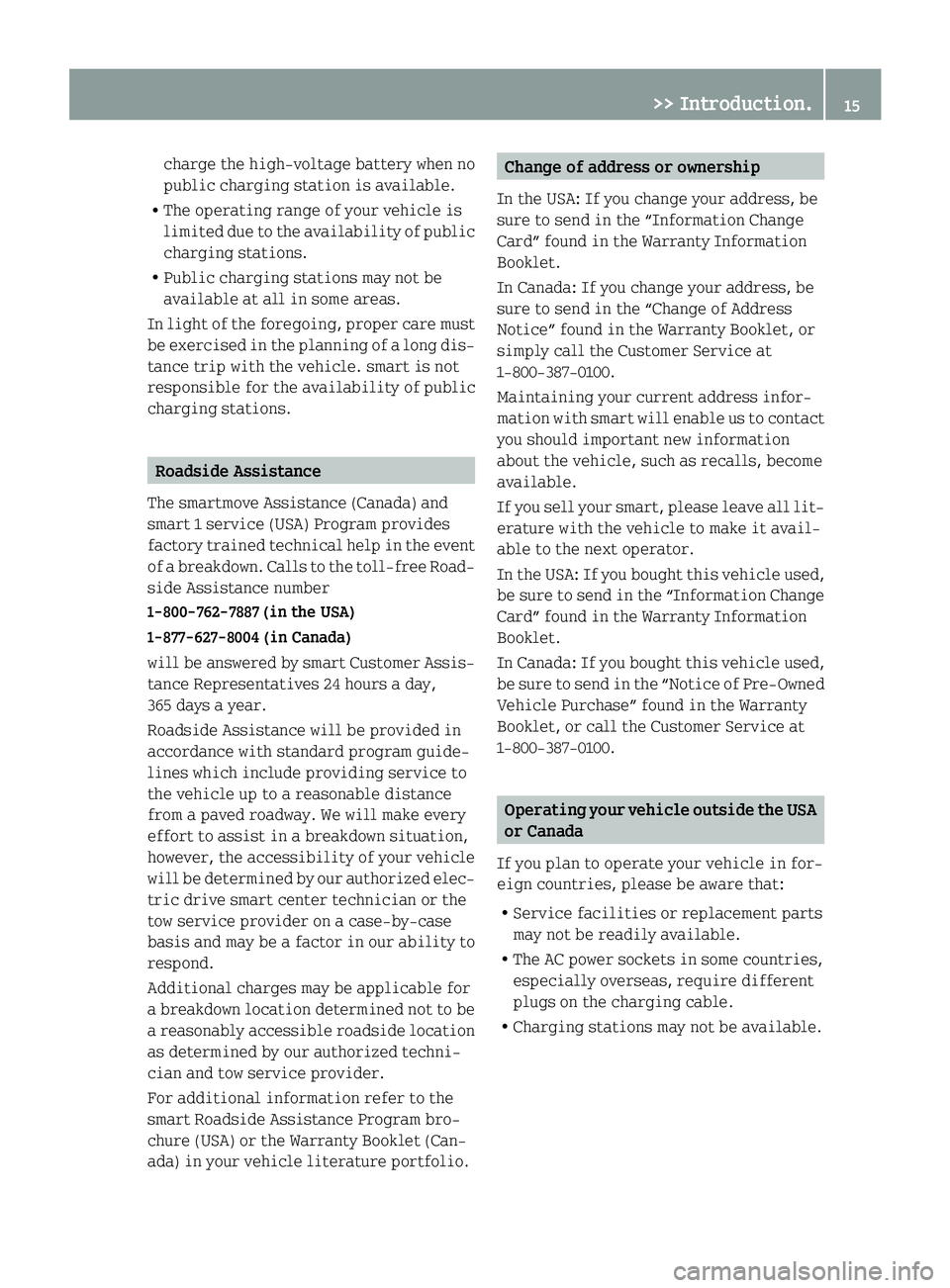
charge the high‑voltage battery when no
public charging station is available.
R The operating range of your vehicle is
limited due to the availability of public
charging stations.
R Public charging stations may not be
available at all in some areas.
In light of the foregoing, proper care must
be exercised in the planning of a long dis-
tance trip with the vehicle. smart is not
responsible for the availability of public
charging stations. Roadside Assistance
The smartmove Assistance (Canada) and
smart 1 service (USA) Program provides
factory trained technical help in the event
of a breakdown. Calls to the toll-free Road-
side Assistance number
1-800-762-7887 (in the USA)
1-877-627-8004 (in Canada)
will be answered by smart Customer Assis-
tance Representatives 24 hours a day,
365 days a year.
Roadside Assistance will be provided in
accordance with standard program guide-
lines which include providing service to
the vehicle up to a reasonable distance
from a paved roadway. We will make every
effort to assist in a breakdown situation,
however, the accessibility of your vehicle
will be determined by our authorized elec-
tric drive smart center technician or the
tow service provider on a case-by-case
basis and may be a factor in our ability to
respond.
Additional charges may be applicable for
a breakdown location determined not to be
a reasonably accessible roadside location
as determined by our authorized techni-
cian and tow service provider.
For additional information refer to the
smart Roadside Assistance Program bro-
chure (USA) or the Warranty Booklet (Can-
ada) in your vehicle literature portfolio. Change of address or ownership
In the USA: If you change your address, be
sure to send in the “Information Change
Card” found in the Warranty Information
Booklet.
In Canada: If you change your address, be
sure to send in the “Change of Address
Notice” found in the Warranty Booklet, or
simply call the Customer Service at
1-800-387-0100.
Maintaining your current address infor-
mation with smart will enable us to contact
you should important new information
about the vehicle, such as recalls, become
available.
If you sell your smart, please leave all lit-
erature with the vehicle to make it avail-
able to the next operator.
In the USA: If you bought this vehicle used,
be sure to send in the “Information Change
Card” found in the Warranty Information
Booklet.
In Canada: If you bought this vehicle used,
be sure to send in the “Notice of Pre‑Owned
Vehicle Purchase” found in the Warranty
Booklet, or call the Customer Service at
1-800-387-0100. Operating your vehicle outside the USA
or Canada
If you plan to operate your vehicle in for-
eign countries, please be aware that:
R Service facilities or replacement parts
may not be readily available.
R The AC power sockets in some countries,
especially overseas, require different
plugs on the charging cable.
R Charging stations may not be available. >> Introduction.
15
Page 180 of 222
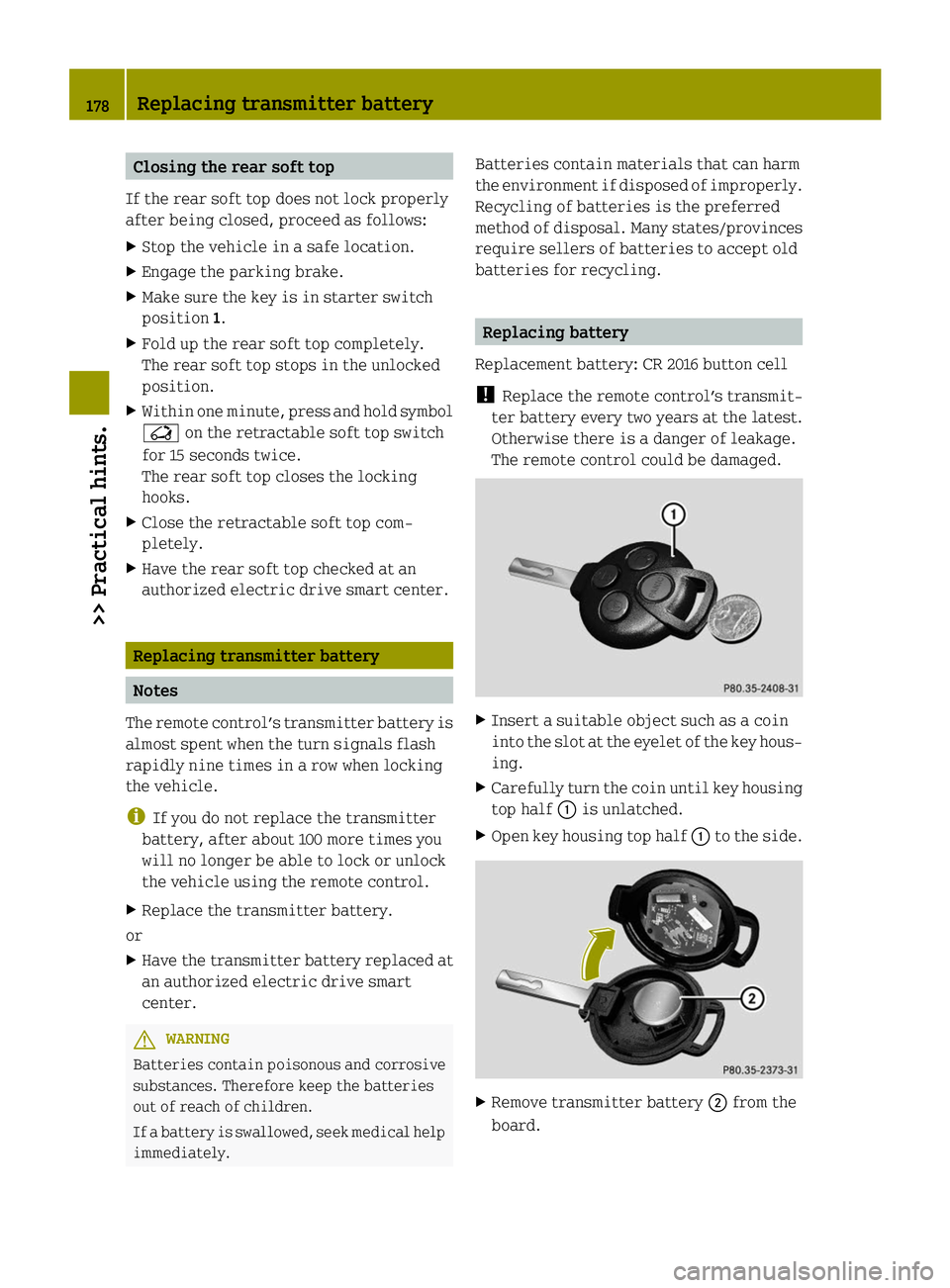
Closing the rear soft top
If the rear soft top does not lock properly
after being closed, proceed as follows:
X Stop the vehicle in a safe location.
X Engage the parking brake.
X Make sure the key is in starter switch
position 1.
X Fold up the rear soft top completely.
The rear soft top stops in the unlocked
position.
X Within one minute, press and hold symbol
0055 on the retractable soft top switch
for 15 seconds twice.
The rear soft top closes the locking
hooks.
X Close the retractable soft top com-
pletely.
X Have the rear soft top checked at an
authorized electric drive smart center. Replacing transmitter battery
Notes
The remote control’s transmitter battery is
almost spent when the turn signals flash
rapidly nine times in a row when locking
the vehicle.
i If you do not replace the transmitter
battery, after about 100 more times you
will no longer be able to lock or unlock
the vehicle using the remote control.
X Replace the transmitter battery.
or
X Have the transmitter battery replaced at
an authorized electric drive smart
center. G
WARNING
Batteries contain poisonous and corrosive
substances. Therefore keep the batteries
out of reach of children.
If a battery is swallowed, seek medical help
immediately. Batteries contain materials that can harm
the environment if disposed of improperly.
Recycling of batteries is the preferred
method of disposal. Many states/provinces
require sellers of batteries to accept old
batteries for recycling. Replacing battery
Replacement battery: CR 2016 button cell
! Replace the remote control’s transmit-
ter battery every two years at the latest.
Otherwise there is a danger of leakage.
The remote control could be damaged. X
Insert a suitable object such as a coin
into the slot at the eyelet of the key hous-
ing.
X Carefully turn the coin until key housing
top half 0043is unlatched.
X Open key housing top half 0043to the side. X
Remove transmitter battery 0044from the
board. 178
Replacing transmitter battery>> Practical hints.
Page 181 of 222
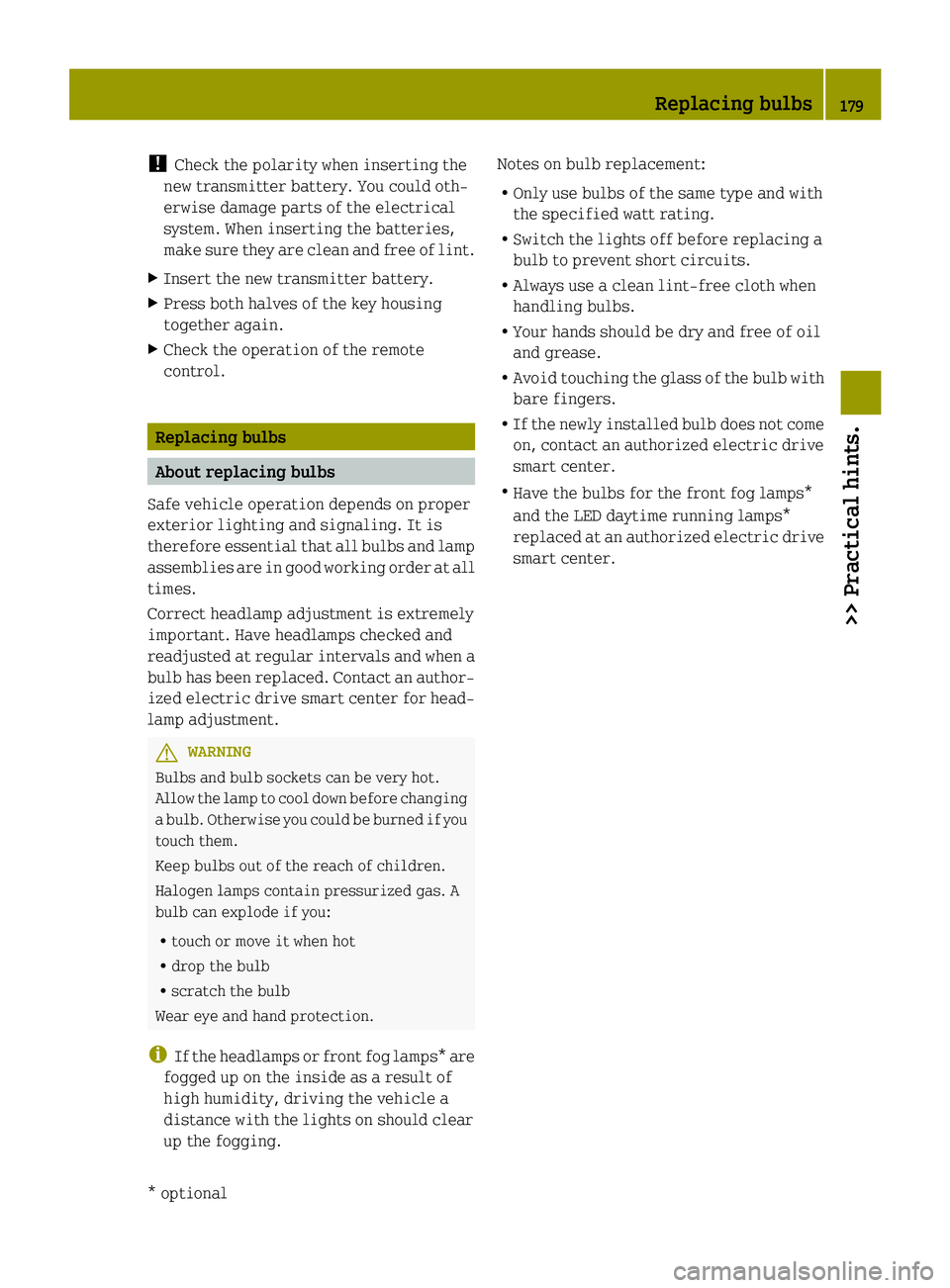
!
Check the polarity when inserting the
new transmitter battery. You could oth-
erwise damage parts of the electrical
system. When inserting the batteries,
make sure they are clean and free of lint.
X Insert the new transmitter battery.
X Press both halves of the key housing
together again.
X Check the operation of the remote
control. Replacing bulbs
About replacing bulbs
Safe vehicle operation depends on proper
exterior lighting and signaling. It is
therefore essential that all bulbs and lamp
assemblies are in good working order at all
times.
Correct headlamp adjustment is extremely
important. Have headlamps checked and
readjusted at regular intervals and when a
bulb has been replaced. Contact an author-
ized electric drive smart center for head-
lamp adjustment. G
WARNING
Bulbs and bulb sockets can be very hot.
Allow the lamp to cool down before changing
a bulb. Otherwise you could be burned if you
touch them.
Keep bulbs out of the reach of children.
Halogen lamps contain pressurized gas. A
bulb can explode if you:
R touch or move it when hot
R drop the bulb
R scratch the bulb
Wear eye and hand protection.
i If the headlamps or front fog lamps* are
fogged up on the inside as a result of
high humidity, driving the vehicle a
distance with the lights on should clear
up the fogging. Notes on bulb replacement:
R
Only use bulbs of the same type and with
the specified watt rating.
R Switch the lights off before replacing a
bulb to prevent short circuits.
R Always use a clean lint-free cloth when
handling bulbs.
R Your hands should be dry and free of oil
and grease.
R Avoid touching the glass of the bulb with
bare fingers.
R If the newly installed bulb does not come
on, contact an authorized electric drive
smart center.
R Have the bulbs for the front fog lamps*
and the LED daytime running lamps*
replaced at an authorized electric drive
smart center. Replacing bulbs
179>> Practical hints.
* optional Z
Page 194 of 222
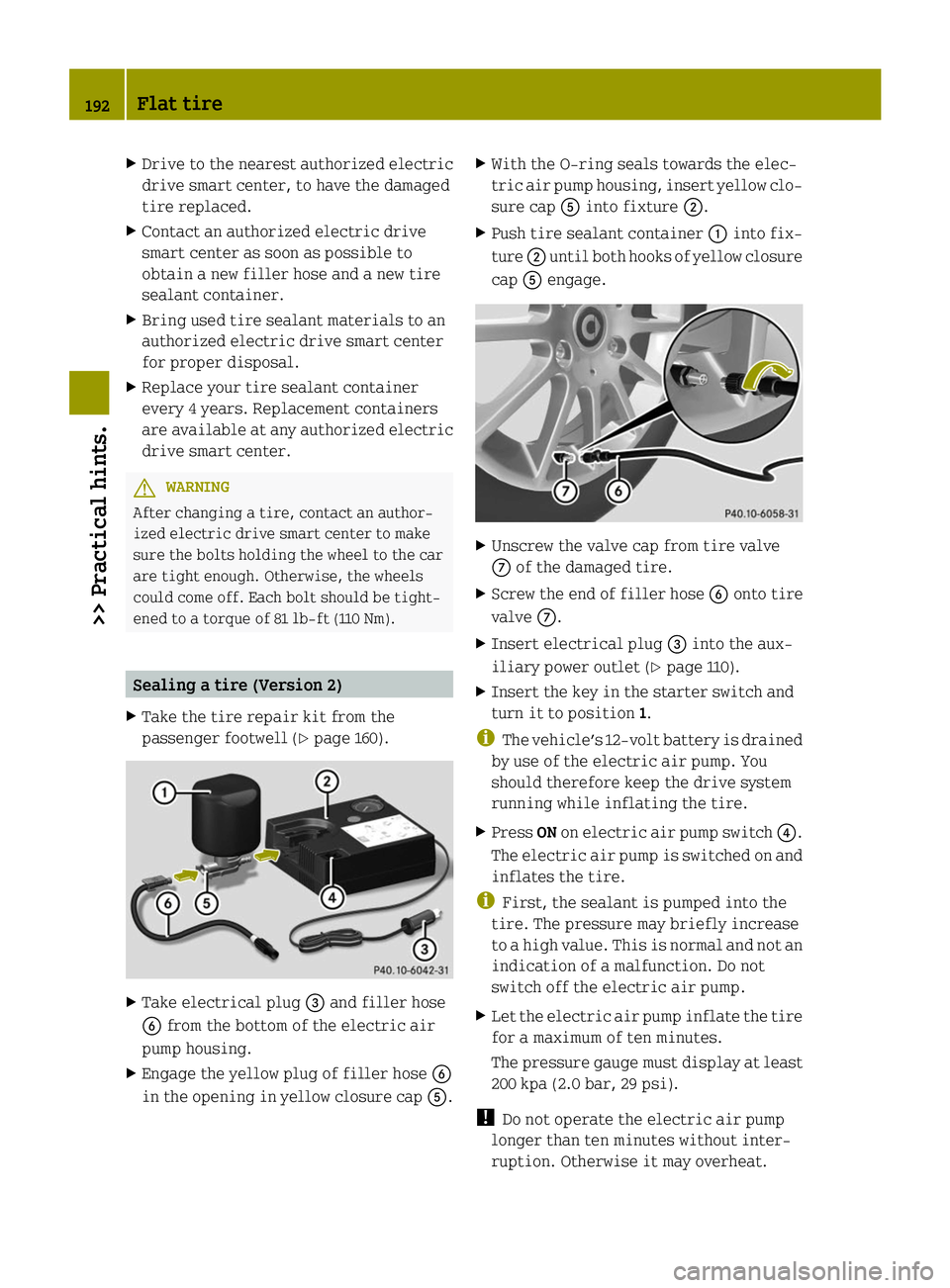
X
Drive to the nearest authorized electric
drive smart center, to have the damaged
tire replaced.
X Contact an authorized electric drive
smart center as soon as possible to
obtain a new filler hose and a new tire
sealant container.
X Bring used tire sealant materials to an
authorized electric drive smart center
for proper disposal.
X Replace your tire sealant container
every 4 years. Replacement containers
are available at any authorized electric
drive smart center. G
WARNING
After changing a tire, contact an author-
ized electric drive smart center to make
sure the bolts holding the wheel to the car
are tight enough. Otherwise, the wheels
could come off. Each bolt should be tight-
ened to a torque of 81 lb‑ft (110 Nm). Sealing a tire (Version 2)
X Take the tire repair kit from the
passenger footwell (Y page 160).X
Take electrical plug 0087and filler hose
0084 from the bottom of the electric air
pump housing.
X Engage the yellow plug of filler hose 0084
in the opening in yellow closure cap 0083.X
With the O-ring seals towards the elec-
tric air pump housing, insert yellow clo-
sure cap 0083into fixture 0044.
X Push tire sealant container 0043into fix-
ture 0044until both hooks of yellow closure
cap 0083engage. X
Unscrew the valve cap from tire valve
006B of the damaged tire.
X Screw the end of filler hose 0084onto tire
valve 006B.
X Insert electrical plug 0087into the aux-
iliary power outlet ( Ypage 110).
X Insert the key in the starter switch and
turn it to position 1.
i The vehicle’s 12‑volt battery is drained
by use of the electric air pump. You
should therefore keep the drive system
running while inflating the tire.
X Press ONon electric air pump switch 0085.
The electric air pump is switched on and
inflates the tire.
i First, the sealant is pumped into the
tire. The pressure may briefly increase
to a high value. This is normal and not an
indication of a malfunction. Do not
switch off the electric air pump.
X Let the electric air pump inflate the tire
for a maximum of ten minutes.
The pressure gauge must display at least
200 kpa (2.0 bar, 29 psi).
! Do not operate the electric air pump
longer than ten minutes without inter-
ruption. Otherwise it may overheat. 192
Flat tire>> Practical hints.
Page 221 of 222
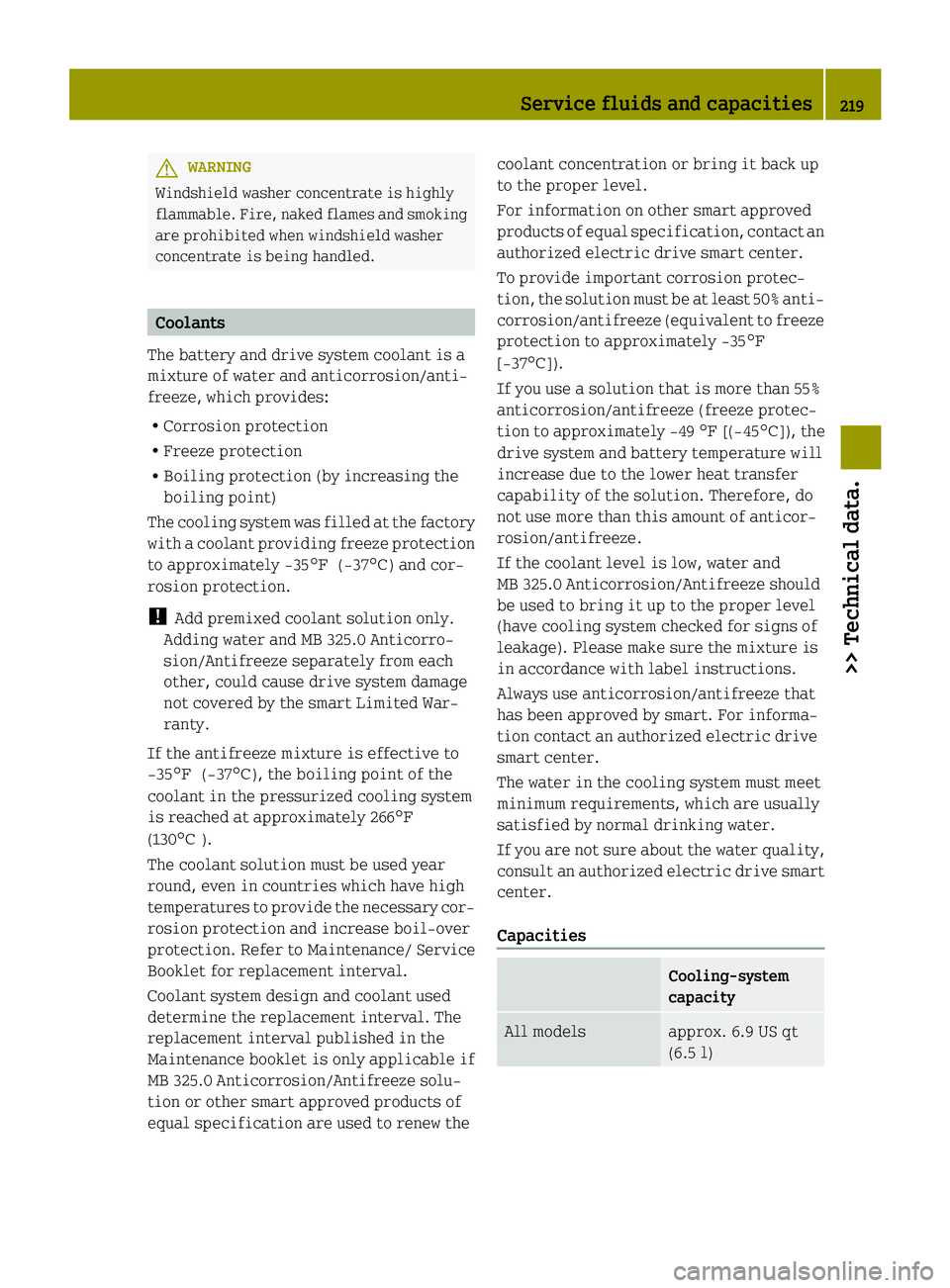
G
WARNING
Windshield washer concentrate is highly
flammable. Fire, naked flames and smoking
are prohibited when windshield washer
concentrate is being handled. Coolants
The battery and drive system coolant is a
mixture of water and anticorrosion/anti-
freeze, which provides:
R Corrosion protection
R Freeze protection
R Boiling protection (by increasing the
boiling point)
The cooling system was filled at the factory
with a coolant providing freeze protection
to approximately -35¦ (-37¥) and cor-
rosion protection.
! Add premixed coolant solution only.
Adding water and MB 325.0 Anticorro-
sion/Antifreeze separately from each
other, could cause drive system damage
not covered by the smart Limited War-
ranty.
If the antifreeze mixture is effective to
-35¦ (-37¥), the boiling point of the
coolant in the pressurized cooling system
is reached at approximately 266¦
(130¥ ).
The coolant solution must be used year
round, even in countries which have high
temperatures to provide the necessary cor-
rosion protection and increase boil‑over
protection. Refer to Maintenance/ Service
Booklet for replacement interval.
Coolant system design and coolant used
determine the replacement interval. The
replacement interval published in the
Maintenance booklet is only applicable if
MB 325.0 Anticorrosion/Antifreeze solu-
tion or other smart approved products of
equal specification are used to renew the coolant concentration or bring it back up
to the proper level.
For information on other smart approved
products of equal specification, contact an
authorized electric drive smart center.
To provide important corrosion protec-
tion, the solution must be at least 50% anti-
corrosion/antifreeze (equivalent to freeze
protection to approximately -35¦
[-37¥]).
If you use a solution that is more than 55%
anticorrosion/antifreeze (freeze protec-
tion to approximately -49
¦[(-45 ¥]), the
drive system and battery temperature will
increase due to the lower heat transfer
capability of the solution. Therefore, do
not use more than this amount of anticor-
rosion/antifreeze.
If the coolant level is low, water and
MB 325.0 Anticorrosion/Antifreeze should
be used to bring it up to the proper level
(have cooling system checked for signs of
leakage). Please make sure the mixture is
in accordance with label instructions.
Always use anticorrosion/antifreeze that
has been approved by smart. For informa-
tion contact an authorized electric drive
smart center.
The water in the cooling system must meet
minimum requirements, which are usually
satisfied by normal drinking water.
If you are not sure about the water quality,
consult an authorized electric drive smart
center.
Capacities Cooling-system
capacity
All models approx. 6.9 US qt
(6.5 l)Service fluids and capacities
219>> Technical data. Z